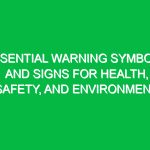Introduction
Understanding the meaning behind warning signage is crucial for anyone involved in health, safety, and environmental (HSE) practices. Warning signage serves as a visual communication tool that conveys important Safety information, alerts individuals to potential Hazards, and guides them in navigating unsafe conditions. In workplaces and public spaces alike, these signs play a pivotal role in preventing accidents and ensuring the well-being of all individuals present.
In this article, we will delve into the meaning of warning signage, its significance in the HSE domain, and the various elements that contribute to effective Safety communication. By exploring key concepts, regulations, and real-life scenarios, we aim to provide a comprehensive understanding of warning signage meaning and its impact on promoting safety and health in various environments.
Understanding Warning Signage Meaning
Warning signage meaning encompasses the interpretation and understanding of various symbols, colors, and text used on safety signs. The primary goal of these signs is to alert individuals to potential risks or dangers. Each sign has a specific meaning, and recognizing these meanings is essential for maintaining safety in any Environment.
Key Components of Warning Signage
Warning signs can be categorized based on their design, color, and the type of hazard they represent. Each component plays a vital role in conveying information effectively. Here are the key elements to consider:
- Color Coding: Colors are pivotal in distinguishing the type of warning sign. For instance, yellow typically indicates caution, while red signifies danger. Green is often used for safety information, and blue denotes mandatory actions.
- Symbols and Icons: Visual symbols are universally recognized and can quickly communicate the nature of the hazard. For example, a lightning bolt represents Electrical Hazards, while a skull and crossbones indicate toxic substances.
- Text Guidance: Accompanying text can clarify the message conveyed by the symbols. It can include instructions, warnings, or information about the nature of the hazard.
The Importance of Warning Signage in HSE
The significance of warning signage in the HSE domain cannot be overstated. These signs help individuals identify risks, make informed decisions, and take appropriate actions to mitigate dangers. Effective warning signage can lead to a considerable reduction in workplace accidents and injuries. Here are a few reasons why warning signage is essential:
- Preventing Accidents: By providing clear information about Hazards, warning signage helps individuals avoid dangerous situations.
- Enhancing Awareness: Regular exposure to warning signs raises awareness about potential risks, contributing to a culture of safety.
- Compliance with Regulations: Many regulations require the use of specific warning signs, ensuring that workplaces adhere to safety Standards.
Types of Warning Signage
Warning signage can be classified into several categories based on the type of hazard they address. Understanding these categories is crucial for effective safety management.
Hazard Signs
Hazard signs indicate the presence of a specific danger. For example, a sign with a biohazard symbol alerts individuals to the presence of biological substances that can pose a risk to health. Recognizing these signs can be the difference between safety and harm.
Prohibition Signs
Prohibition signs indicate actions that are not allowed, such as “No Smoking” or “Do Not Enter.” These signs are crucial for maintaining safety protocols and preventing dangerous behaviors in Hazardous Areas.
Mandatory Action Signs
Mandatory action signs instruct individuals to take specific actions, such as wearing Personal Protective Equipment (PPE). For instance, “Hard Hat Required” ensures that workers are aware of the need for head protection in certain environments.
Emergency Signs
Emergency signs provide information about emergency exits, first aid stations, and fire safety equipment. These signs are vital for ensuring that individuals can respond effectively in emergencies.
Real-Life Scenarios and Anecdotes
To illustrate the importance of warning signage meaning, let’s consider a hypothetical scenario in a manufacturing facility. Workers in this facility are required to navigate areas with heavy machinery. Each area is equipped with clear warning signs indicating specific hazards, such as “High Noise Area” and “Forklift Traffic.”
One day, a new employee, unfamiliar with the layout, disregards a “Caution: Slippery Floor” sign. The result? A slip and fall that could have been prevented. This incident emphasizes the necessity of clear and understood warning signage. If the employee had recognized the meaning of the sign, they could have taken steps to avoid the hazard.
Best Practices for Implementing Warning Signage
To maximize the effectiveness of warning signage in the HSE context, certain Best Practices should be followed:
- Regular Audits: Conduct regular audits of signage to ensure that all signs are visible, legible, and relevant to current hazards.
- Training Programs: Incorporate Training programs that educate employees on the meanings of various warning signs and their importance in Workplace Safety.
- Clear Placement: Position signs in locations where they can be easily seen and understood by individuals at risk.
Regulations and Standards Governing Warning Signage
In many countries, there are specific regulations and standards that govern the use of warning signage. These regulations are designed to ensure that safety signs are consistent, effective, and understood by all users.
OSHA Standards
In the United States, the Occupational Safety and Health Administration (osha) has established standards for safety signage. These standards dictate the design, placement, and wording of warning signs in workplaces. Compliance with OSHA regulations not only ensures safety but also protects organizations from legal repercussions.
ISO Standards
Internationally, the International Organization for Standardization (ISO) provides guidelines for safety signage. ISO 7010, for example, outlines standardized safety signs that can be recognized across different countries. This standardization is especially beneficial in global industries where workers may come from diverse backgrounds.
Impact of Regulations on Warning Signage Meaning
By adhering to these regulations and standards, organizations can enhance the understanding of warning signage meaning. Consistent signage enables individuals to recognize hazards quickly, facilitating a safer working environment. Additionally, compliance with regulations fosters a culture of safety and accountability within organizations.
Conclusion
In summary, understanding warning signage meaning is essential for promoting health, safety, and environmental Sustainability. Effective warning signage serves as a critical tool in preventing accidents, enhancing awareness, and complying with regulatory requirements. By recognizing the various components, types, and Best Practices associated with warning signage, individuals and organizations can create safer environments.
As we continue to prioritize safety in our workplaces and communities, let us remain vigilant in our understanding of warning signage meaning. It is not merely a matter of compliance; it is a commitment to the well-being of everyone involved. By fostering this awareness, we can contribute to a culture of safety that Benefits all.


